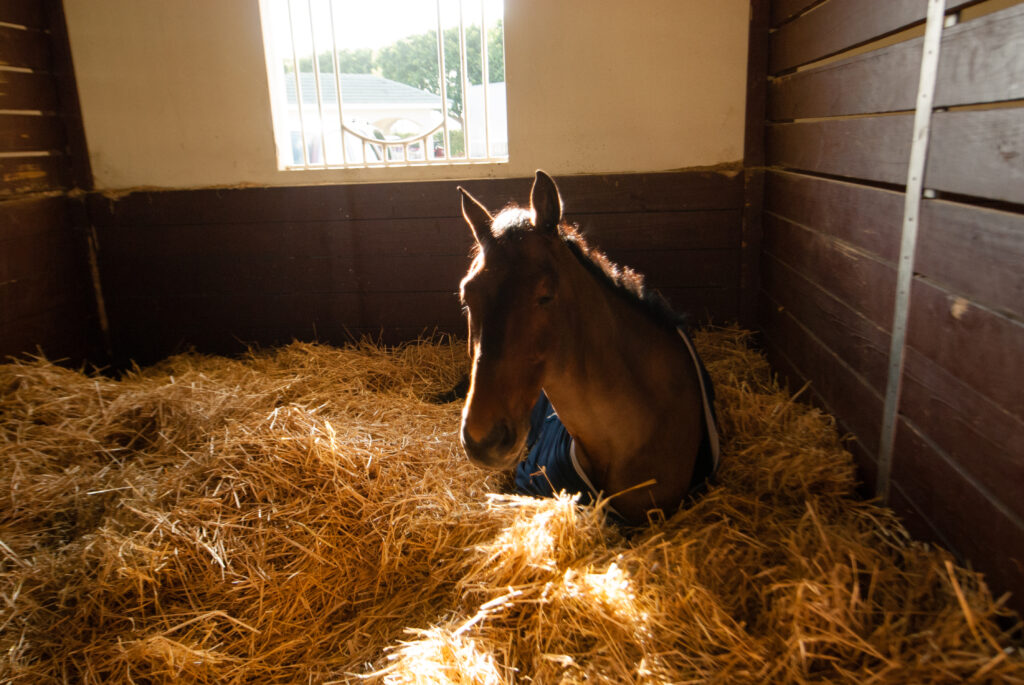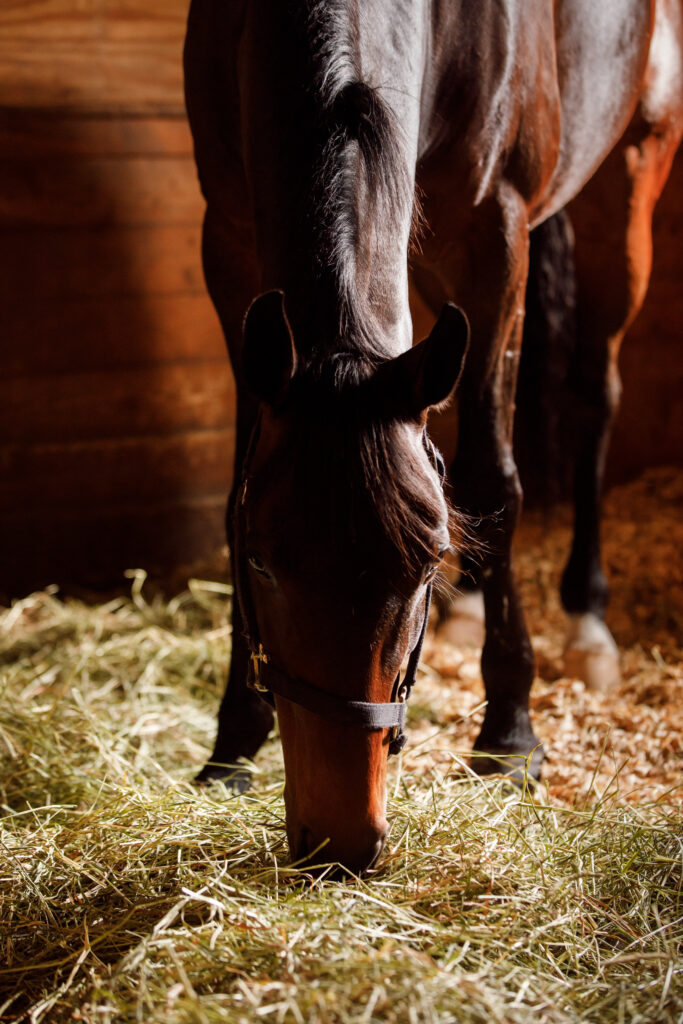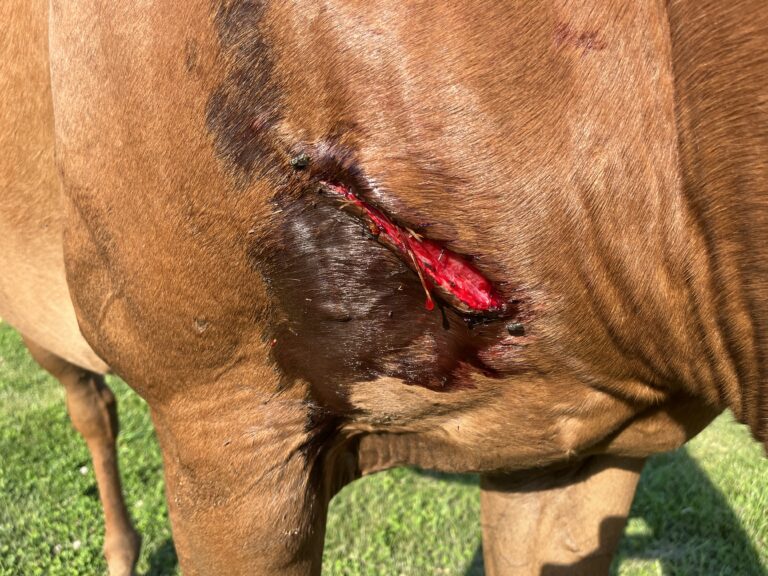Question: My 10-year-old event horse, a Thoroughbred gelding, suffered a mild suspensory strain during our final competition of the season. As part of his treatment, our veterinarian recommended stall rest. I know this will benefit the ligament as it heals, but I’m concerned about the effect of extended confinement on my horse’s overall well-being. He’s normally an active and social creature, who enjoys turnout and the companionship of other horses. What can I do to lessen the stress he may experience while spending more time than usual in his stall?

© Sandra Oliynyk
Answer: Your veterinarian is right to prescribe stall rest to control your horse’s level of activity as his suspensory ligament heals. You’re right, too, to be concerned that this necessary but abrupt change in your gelding’s lifestyle may come with a downside. Fortunately, there are a number of things you can do to ease his anxiety during his confinement. Consult your veterinarian as you explore the possibilities for your individual horse and situation. Here are some ways to keep him safe, occupied and relaxed until he’s ready to ease back into activity and eventually return to his normal routine.
Consider location. A horse who generally shows interest in what’s going on around him might fare better confined to a stall that has a view of the aisle or other area of the barn where there’s a lot of activity—for instance, the wash stall or tack room. A window that looks out onto the pasture and beyond would be another good choice. The abundant natural light it supplies will be a plus. One caveat: A horse who can only watch the action may feel left out and despair at being unable to join, especially if his stall is near a door where others are coming and going. So you’ll want to balance his need for entertainment with his desire to participate when choosing a spot.
Arrange for company. As much as your gelding may benefit from being able to observe what’s going on in the barn, having a buddy in the next stall or across the aisle may help to keep him from feeling lonely. It needn’t be the same horse day in and day out. His companions can rotate as needed. Or maybe—if space and your horse’s temperament allow—he would welcome sharing his stall with a small pony, goat, sheep or even a chicken.

© Shelley Paulson
Prioritize safety. Before settling your recuperating horse into any stall, thoroughly inspect it for potential trouble spots and correct them. See that the walls are in good condition with no loose, rough or splintered boards or protruding nails. Check for space between the wall boards and floor where a reclining horse could catch a hoof. Look for unevenness and damp spots in the floor. Test that the door latch is in good working order and difficult for a curious horse to reach or manipulate. The same goes for any wiring and light fixtures in or near the stall. Verify that the hardware holding the window grate, feeder and water bucket is secure and free of sharp or rough edges.
Make it comfortable and clean. For as long as your horse is confined, provide plenty of high-quality, low-dust bedding—perhaps atop a rubber stall mat—so his body will be well-cushioned if he lies down. Remove waste material twice daily, if possible, and replace it with clean bedding. Check that the stall is well ventilated but not drafty. Excessive moisture, dust and odor—which can result from insufficient airflow in a horse’s environment—are all threats to his respiratory health. Consider using a stall deodorizer to absorb ammonia from urine if it becomes a problem. Be mindful, too, of flies and other insects becoming an annoyance. A fan, repellant or fly sheet may be necessary to keep them off your horse and under control.
Lavish him with attention. Plan plenty of visits to the barn to break up the monotony of your gelding’s day and help him maintain a sense of routine. Horses are creatures of habit, and one who’s confined to a stall is likely to be reassured by the regular activities of everyday life, such as a good grooming session. Now is also the time to be a bit indulgent: Massage or gentle stretching exercises—if your veterinarian agrees—can help your gelding stay flexible while he’s sidelined.
Daily visits will also give you the opportunity to gather important information about your horse’s general health and rate of healing. Note his attitude and behavior and monitor his intake of feed and water and his output of manure and urine. Noticeable changes can be signs of developing trouble: Horses on stall rest have an increased risk of colic and gastric ulcers. You’ll also be able to tell how well your horse has adjusted to inactivity. Talk to your veterinarian if your gelding is especially anxious or seems miserable. A sedative or other preparation (B vitamin, magnesium sulfate or herbal product, for instance) may be beneficial.

© Amy K. Dragoo
Feed for need. Reduced activity means that your stall-bound horse requires fewer calories to maintain his weight. So cut down on the grain in his diet and increase the forage. Supply him with mature grass hay and feed it in a net to prolong the time it takes for him to eat it. Talk with your veterinarian about feeding a ration balancer containing vitamins and minerals or adding a supplement to support digestion or have a calming effect.
Try a toy or some tunes. Left to his own devices a bored horse on stall rest could develop troublesome behaviors such as cribbing, pawing, weaving or kicking. But you can capture his attention and help him channel his energy by offering him something to play with. There are all types of balls designed specifically for horses. Some hold feed or treats that a horse has to work to get. You can also give him a sturdy stuffed animal, place a traffic cone in his stall or suspend a milk jug from the ceiling on a length of rope that’s secure. Mount an unbreakable mirror to a strategic spot and your gelding will have a buddy to engage with. He also may enjoy the sound of music while he’s confined. Research has shown it can have a calming effect (see “A Noteworthy Offer” below). Choose a style that’s soothing—try country or classical or smooth jazz—and play it at a moderate level.
Ease back into activity. When the time is right, your veterinarian will give you the go-ahead to hand-walk or hand-graze your horse, likely in a confined outdoor area to start. At some point, you may be able to pony your gelding or lightly ride him at a walk. Until that time arrives, you can teach or review ground exercises to challenge your horse’s mind. Have him lower his head, yield laterally, back up or stand ground-tied. Eventually, healing will progress to the point where your horse is ready for increased controlled exercise and finally, a full return to work.
A Noteworthy Offer
Wondering whether your playlist includes tunes to soothe your stall-bound horse? The pharmaceutical company Boehringer Ingelheim, producer of UlcerGard® (omeprazole), may have just the option you’re looking for: a musical arrangement called Relax Trax, composed specifically to alleviate stress in horses and available from the company as a free download.
Introduced two years ago, the composition was created by Janet Marlow, an animal sound behaviorist and founder of Pet Acoustics, Inc. She used specific rhythms to mimic a horse’s gaits and the sound of string and keyboard instruments to produce a calming effect. The music also takes into account a horse’s hearing range and sensitivity to produce sounds that are soothing. Its effect was tested through clinical studies and in barns. Results showed a lessening of physical tension in horses and an increase in behaviors associated with relaxation: chewing, yawning, soft eyes and a loose, hanging jaw.
The company indicates that Relax Trax can be a beneficial relaxation tool for any horse experiencing stress, which can lead to larger health problems and poor performance. A video explains the science behind Relax Trax. An audio sample can be found here.—Mary Kay Kinnish
Practical Horseman thanks Bradford Bentz, VMD, MS, DACVIM, ACVECC, ABVP (equine), for reviewing this article. He practices at Equine Medicine and Surgery LLC, in Bossier City, Louisiana.
This article originally appeared in the Winter 2023 issue of Practical Horseman.











